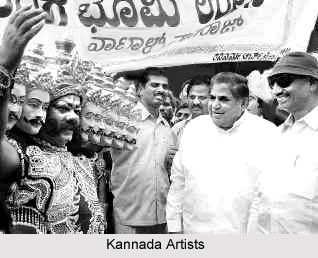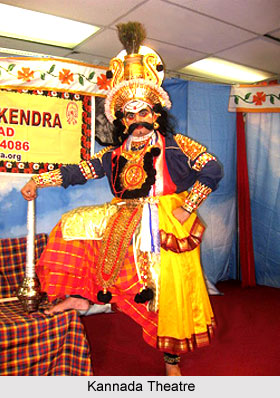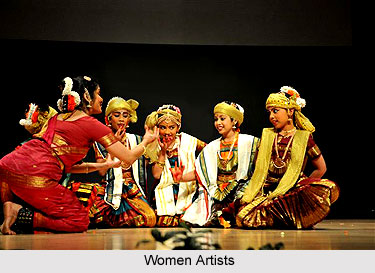 Development of Kannada theatre has been quite significant over the last century. There have been, though a little slow, major progresses made. With regard to professional and amateur theatre, considerable improvements have been made in the process of showmanship. Enhancements have also been made with regard to some of the fundamental aspects of stage - stage sound, light, settings, make-up, costumes, scenery and also methods of portrayal.
Development of Kannada theatre has been quite significant over the last century. There have been, though a little slow, major progresses made. With regard to professional and amateur theatre, considerable improvements have been made in the process of showmanship. Enhancements have also been made with regard to some of the fundamental aspects of stage - stage sound, light, settings, make-up, costumes, scenery and also methods of portrayal.
Performances of Kannada Theatre
Performance of Kannada theatre mainly consisted of tremendous acting. The performances were enacted by men, even the role of female was done by men. The stage, lighting, set designing, and scenery played a crucial part in the performance. The make up used or costumes worn, both exuded simplicity, yet justified the role brilliantly. Lead actors had their own make up boxes. It was on this box the lamp was placed and all the actors sat around, with small mirrors in hands while colouring the faces. The size of the mirror usually indicated the status of the actor.
Plays of Kannada Theatre
 The plays were mostly written on mythological themes. If, there arose, a desire among the people of the village to see a different play, it was soon got up and staged without much difficulty, as it was only the theme that would be really altered rather than the costumes, make up, settings or scenery. Mostly the available songs were freely drawn upon with minor alterations to suit the new play. The plays were infested with songs. The audience would not consider him an actor who did not sing a good number of songs. Each time when the curtain came down, it was a custom to sing again from behind the screen in order "to engage" the audience.
The plays were mostly written on mythological themes. If, there arose, a desire among the people of the village to see a different play, it was soon got up and staged without much difficulty, as it was only the theme that would be really altered rather than the costumes, make up, settings or scenery. Mostly the available songs were freely drawn upon with minor alterations to suit the new play. The plays were infested with songs. The audience would not consider him an actor who did not sing a good number of songs. Each time when the curtain came down, it was a custom to sing again from behind the screen in order "to engage" the audience.
Playhouses in Kannada Theatre
Even after the turning of century, the old stages have been persisted with. With time the performances of the troupes have improved and became more natural and imposing. The troupes with more money arranged tents to provide better accommodation to audience and the less privileged ones suffered. In the cities, however, the halls lacked spaces. So a tradition of constructing new playhouses and stages was kick started by the Palace Company of Mysore in the later part of last century. The Gubbi Company, during its extensive touring of South India after 1935, had to move only in special trains because of its huge equipment and personnel. Not all playhouses that were built had proper amenities, but most of them took care of the basic requirements.
Stage Setting in Kannada Theatre
For most part of the nineteenth century, the main theme was based on Gods, Kings and Queens, and the plays mainly went on for five hours at stretch. This five hours duration continued till 1928, and after serious criticism from the audiences and critics, the length of plays were reduced to about four hours by 1940.
During this period the idea of stage setting and scenery was taken care of in order to creating and sustaining the illusion of the drama. The theatre troupes realized the significance of scenery, costumes and settings, hence laid more emphasis on the same.
In order to add flavour to a performance music too played a key role. The use of music has always been rampant in professional and amateur theatre of Karnataka. The music was mainly influenced by folk tunes.
Women in Kannada Theatre
 Unlike West Bengal, and like Maharashtra, Kannada theatre, particularly in its early period, avoided woman on the stage. Various theatre groups had smooth run without including women in theatres. Even the best of actors while portraying lofty roles like that of Seeta, Savitri and Radha could at best express lust but not love. With time women actors were infused into Kannada theatre. Number of women-artists increased sharply with coming of talented artists like K. Aswathamma (Bharata Janollasini Sabha and later, Gubbi Company) Tripuramba ( Gubbi Company ), Lahshmibai ( Sahitya Samrajya Nataka Mandali ), M. V. Rajamma ( Chandrakala Nataka Mandali of Peer ), B. Jayamma ( Gubbi Company ), Gangubai Guledgudd ( Viswa Gunadarsha Mandali of Vamanarao Master ) etc. Apart from them, actresses like Gangubai Ouledgudda of North Karnatak, Nanjasani of Bangalore and Kama-lamma and Lakshmasani of Mysore founded and led their own professional troupes.
Unlike West Bengal, and like Maharashtra, Kannada theatre, particularly in its early period, avoided woman on the stage. Various theatre groups had smooth run without including women in theatres. Even the best of actors while portraying lofty roles like that of Seeta, Savitri and Radha could at best express lust but not love. With time women actors were infused into Kannada theatre. Number of women-artists increased sharply with coming of talented artists like K. Aswathamma (Bharata Janollasini Sabha and later, Gubbi Company) Tripuramba ( Gubbi Company ), Lahshmibai ( Sahitya Samrajya Nataka Mandali ), M. V. Rajamma ( Chandrakala Nataka Mandali of Peer ), B. Jayamma ( Gubbi Company ), Gangubai Guledgudd ( Viswa Gunadarsha Mandali of Vamanarao Master ) etc. Apart from them, actresses like Gangubai Ouledgudda of North Karnatak, Nanjasani of Bangalore and Kama-lamma and Lakshmasani of Mysore founded and led their own professional troupes.




